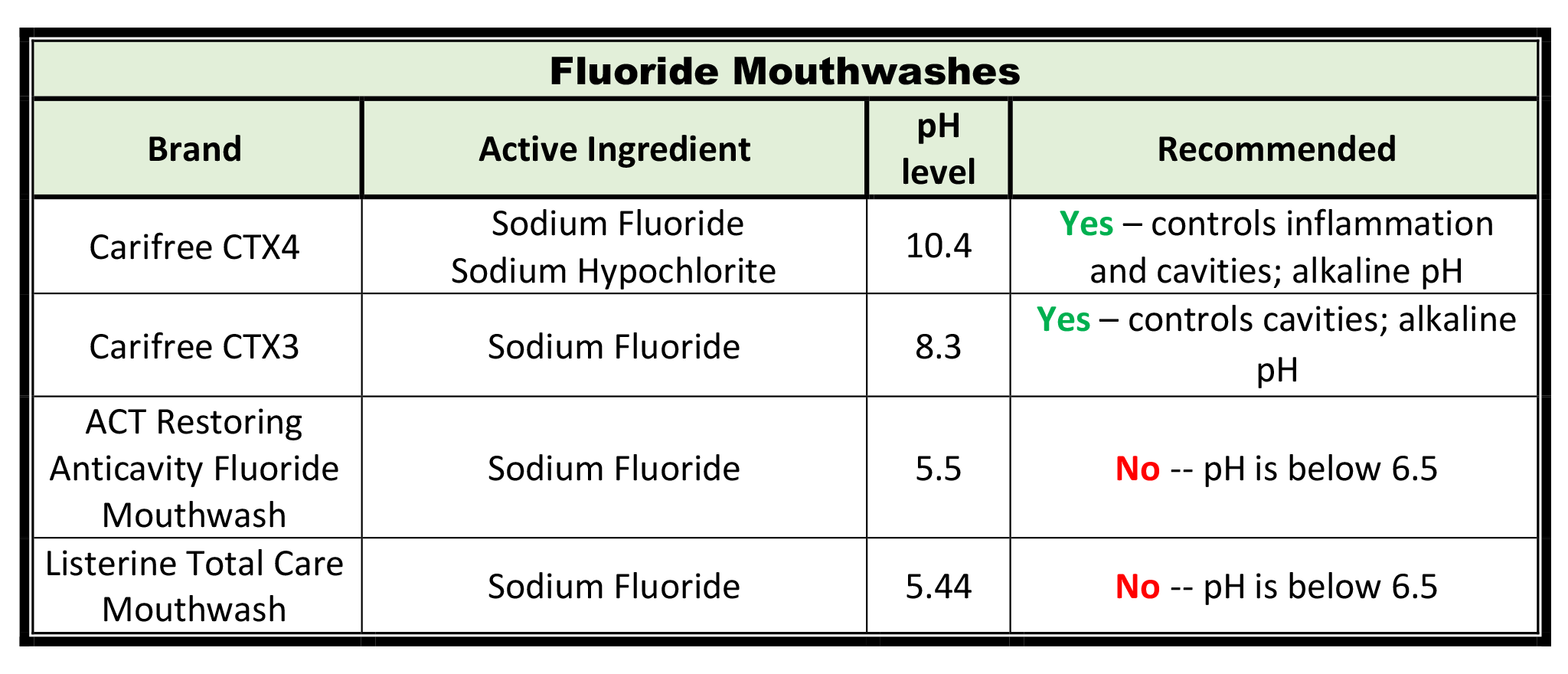Is Your Mouthwash Helping or Hurting Your Teeth?
So Many Options
If you’ve ever spent time in the oral health section of a store, your eyes have been bombarded with labels claiming to be the best product on the shelf -- many with an ADA seal of approval on respected brands. Most lay people (and even some professionals) can find the products confusing. When you’re done reading this article, you should have a better understanding of what mouthwashes are for, what their active ingredients do, and the unintended consequences of using one with a low (acidic) pH level.
Reasons for Using a Mouthwash
The most common reason for using a mouthwash is to improve bad breath. Sources of bad breath include poor oral hygiene, tonsil stones, postnasal drip, periodontal (gum) disease, active decay or untreated abscesses -- all of which have a common denominator in bacteria 1. If this is the reason you’re using an oral rinse, you should first seek professional care and then consider using an antimicrobial mouthwash; a fluoride or essential oils’ rinse will only mask the real problem.
The second most common reason for using a mouthwash is to prevent cavities. In this case you need a fluoride rinse. While fluoride is effective for reducing decay, it is only one factor in the equation of cavity formation. The other major contributor is a pH level below 5.5 -- the point at which enamel begins to demineralize.2 In this weakened state, teeth are more vulnerable to decay, erosion and sensitivity which makes the choice of an acidic mouthwash a bad one.2,3
Most Mouthwashes are Acidic
Ironically, most mouthwashes are acidic with pH levels ranging between 3-6. While the hard, outer layer of the tooth (enamel) demineralizes at 5.5, the softer areas of recession (dentin) erode at just 6.5.3 If you have receding gums and are experiencing sensitivity, an acidic mouthwash can actually compound the problem.
It’s All About the pH
An effective rinse really comes down to the active ingredients plus an alkaline pH (one that is above 6.5 in order to avoid both enamel and dentinal erosion). Below I categorized mouthwashes into their basic types: antimicrobial, fluoride, and essential oils; and then subcategorized them by their active ingredients, pH levels and recommendation status. Note that the active ingredient does not necessarily correspond to the pH: comparing Therabreath to Crest ProHealth is a good example – they both use Cetylpyridinium Chloride -- but their pH levels are very different. The levels used in this chart are taken from cited sources 4 and independently verified by my own pH tests.
My Go-To Recommendations:
The two products I most commonly recommend are Closys and Carifree. Both are pH+ and readily available on Amazon.com. Closys is my preferred rinse for patients with inflamed or bleeding gums and Carifree is my recommendation for patients at high risk for decay or who have active cavities.
If you have questions this article did not answer, feel free to message or email me. If you live in the DC Metro area you can always feel free to schedule a dental visit with me.
References:
1. Deus FP, Ouanounou A. Mouthwashes and their use in dentistry: a review. Published March 21, 2021 in OralHealth. Retrieved from: oralhealthgroup.com/features/mouthwashes. Accessed December 14, 2021.
2. Delgado AJ, Dias Ribeiro AP, Quesada A, et al. Potential erosive effect of mouth rinses on enamel and dentin. Gen Dent. 2018;66(3):75-79.
3. Guignon A. Dental erosion: an increasingly common cause of dentin hypersensitivity. Retrieved from: colgate.dentalaegis.com. Accessed December 14, 2021.
4. Kois Center. Rinse pH values. Retrieved from: Rinse-pH-Values.pdf (koiscenter.com). Accessed December 14, 2021.
5. Langa GPJ, Muniz FWMG, Costa RDSA, da Silveira TM, Rösing CK. The effect of cetylpyridinium chloride mouth rinse as adjunct to toothbrushing compared to placebo on interproximal plaque and gingival inflammation-a systematic review with meta-analyses. Clin Oral Investig. 2021;25(2):745-757. doi:10.1007/s00784-020-03661-2.
6. Overholser CD, Meiller TF, DePaola LG, Minah GE, Niehaus C. Comparative effects of 2 chemotherapeutic mouth rinses on the development of supragingival dental plaque and gingivitis. J Clin Periodontol. 1990;17(8):575-579.
7. Shewale JG, Gelhaus HC, Ratcliff JL, Hernandez-Kapila YL. In vitro antiviral activity of stabilized chlorine dioxide containing oral care products. Oral Dis. 2021;10.1111/odi.14044. doi:10.1111/odi.14044.
8. James P, Worthington HV, Parnell C, et al. Chlorhexidine mouth rinse as an adjunctive treatment for gingival health. Cochrane Database Syst Rev. 2017;3(3):CD008676. doi:10.1002/14651858.CD008676.pub2 (chlorhexidine staining)
9. Morton L, Siu ATY, Fowler S, Zhou C, Nixon C, Campbell D. A randomized controlled pilot trial of two interventions to manage dry mouth in pre-operative elective surgical patients. Pilot Feasibility Stud. 2020;6:89. doi:10.1186/s40814-020-00630-0.



